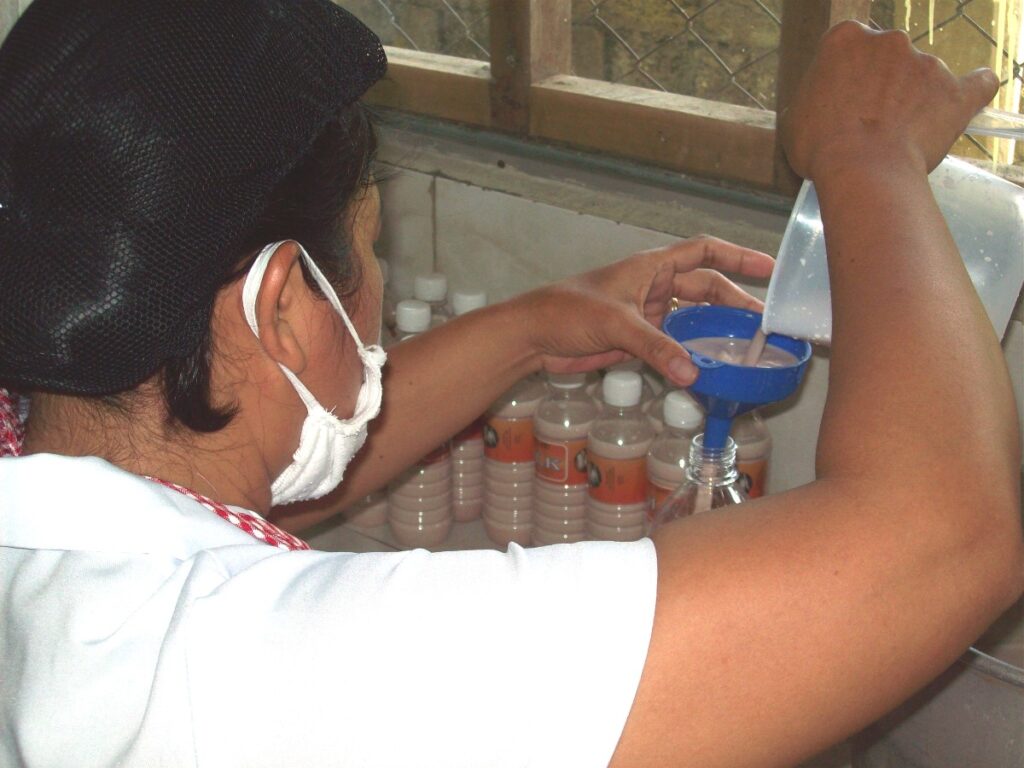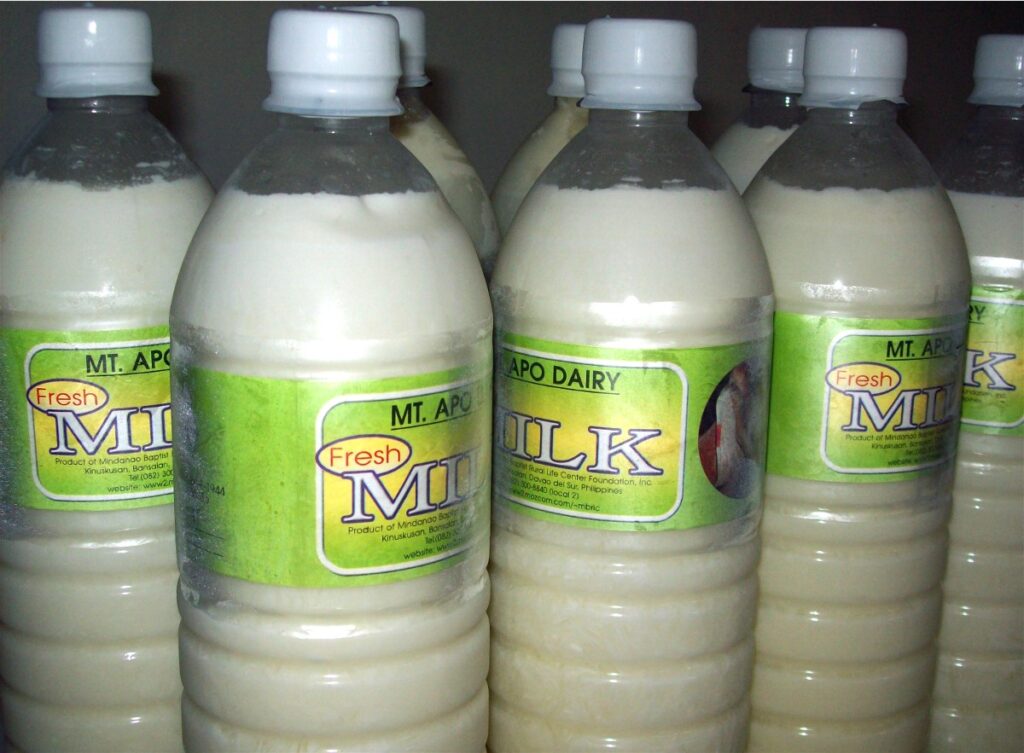Text and Photos by Henrylito D. Tacio
Milk is the ideal food, meeting human nutritional needs better than any other single food item. It is rich in most of the nutrients needed by the human body. That is why newly-born babies can subsist solely on milk in the first few months of their lives.
In recent years, working mothers are no longer breastfeeding their children instead of using commercial milk products. But with the recent milk crisis – due to a series of deaths of infants in China that were traced to the contamination of infant formula with the toxic chemical melamine – mothers are now thinking of using fresh milk.
Next to mother’s milk, what is the most important milk for children?
There are three chief sources of milk in the Philippines: cattle, carabao, and goat. Of these three animals, the goat is the least expensive to raise, and its milk is the best for infants and children.
“Studies conducted in the United States and other countries showed that goat’s milk is comparable to that of mother’s milk,” says Jethro P. Adang, the director of the Bansalan-based Mindanao Baptist Rural Life Center (MBRLC) Foundation, Inc.
The fat globules of goat’s milk are small in size, friable, and the curd is light in comparison to that of milk from cows and carabaos. “These factors make it easily digestible and explain why goat’s milk is commonly prescribed for infants,” explains Adang.
“I let my two children drink goat’s milk when they were still kids,” said Rodolfo Dedeles, former MBRLC livestock supervisor. “When they were growing up, I observed that unlike other children, they didn’t have many health problems.”

A study conducted by the Department of Science and Technology (DOST) showed that goat’s milk as per 200-milligram serving could provide 20 percent of the daily requirements for calcium, four percent for vitamin A, and eight percent iron.
The fat and protein of goat’s milk are finely divided, which makes it more easily digestible. “Goat’s milk can be digested within 20 minutes compared to cow’s milk which takes at least two to three hours to be digested,” said Israel Guanga, the center’s goat supervisor.
Whereas cow’s milk is acid in reaction, goat’s milk is distinctly alkaline, thereby making it useful in hyperacidity cases. For those who are lactose intolerant, goat’s milk would be a good alternative.
There are many other health benefits from drinking goat’s milk. Goat’s milk has long been used and recommended to aid in the treatment of ulcers due to its more effective acid buffering capacity. Children on goat’s milk have been observed to sleep through the
night and remain more satisfied between meals.
“Indeed, I find among the writers, that the milk of the goat is next in estimation to a woman; for it helpeth the stomach, removeth oppilations and stoppings of the liver and looseth the belly.” This startling testimonial from sixteenth-century William Harrison echoes the opinion of 2,000 years of medical writing. Hippocrates, touted to be the father of medicine, commended the virtues of goat’s milk.
“Why don’t we develop our dairy industry by raising goats?” asked Adang. “If all farmers in the Philippines will raise goats in their farms, we can help the country by saving our dollars in importing those milk and milk products from other countries.”
Although considered a vital component of the country’s economic and nutritional development, the Philippine dairy industry has remained badly underdeveloped. Although the Philippine Dairy Corporation is making some headway, the government is still far behind its target of 20 percent national sufficiency in milk. The Philippines still depends on imports for at least 99 percent of its dairy food requirements.
“With domestic milk production able to supply only one percent of the country’s dairy needs,” reports the United States Department of Agriculture (USDA), “the Philippine will continue to rely on imports to meet the requirements of its growing domestic and export markets.” New Zealand is the country’s top source of dairy products. The Philippines also imports milk products from China because they are cheaper.
For the United States, the Philippines is the largest Southeast Asian market for its dairy products. “Dairy products are the country’s second-largest agricultural import after wheat,” the USDA reports. Despite this, the Philippines’ annual per capita consumption of dairy products is just 16 kilograms or roughly half of the Recommended Daily Allowance.

Low milk consumption is especially pronounced in rural areas where products that need refrigeration are considered a luxury. Metropolitan Manila and nearby provinces in Luzon, which accommodate about a quarter of the population, account for 45 percent of the total dairy expenditure. Milk consumption in Metro Manila is estimated at four times the national average, while less developed areas generally have lower than average consumption.
Adang bats for the raising of goats to combat malnutrition, which is prevalent among rural areas. “If farmers can raise their own source of fresh milk, they don’t need to have refrigerators,” he said.
The goat was one of the first animals to be domesticated. It has a considerable place in mythology; Pan, the Greek god, as half-goat. The word “capricious,” which means “whimsical or irrational,” is derived from caper, the Latin word for goat.
There are many advantages to raising goats on a farm in the backyard. They require smaller capital investment than cattle. They multiply faster than cattle or carabaos. Before a goat is three years old, she can have given birth to as many as five kids.
Goats are usually docile and can be raised by anyone. Where cows or carabaos may be too large for women or children to handle, the goat is just the right size of animal for them to raise. Goats are also friendly and intelligent.
Goats require less feed than cows and carabaos. About ten native goats can be fed on the feedstuffs sufficient for one cow. And about 6-7 purebred dairy goats can be fed on the feedstuff sufficient for one dairy cow.
Under orchards and coconut plantations, goats are good clippers of weeds. They also provide manure for fishponds, farms, and gardens. In some cases, farmers can use goats as “insurance” against the failure of their crops.
Although a goat is small, she can produce as much as four liters of milk every day – if she is purebred and is given a ration to meet all of her nutritional requirements.

